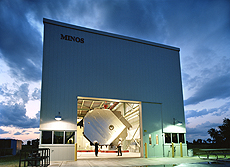MINOS+ adds to the book on neutrinos
 |
A new phase of the MINOS experiment, called MINOS+, will take scientists into new neutrino terrain. Photo: Peter Ginter |
Fermilab's MINOS neutrino experiment entered a new stage this year, marked by a new name: MINOS+.
Using a higher-energy and higher-power neutrino beam than its predecessor, the experiment's second stage explores new territory in neutrino interactions. It also coaxes many times the number of interactions from neutrinos as they pass through the MINOS detector than could the original setup. With MINOS+, scientists hope to uncover new behavior not visible in MINOS' first phase, which lasted from 2005 to 2012.
Since 2001, when scientists first confirmed the phenomenon of neutrino oscillation, researchers have been studying precisely how neutrinos change from one of their three types into another. A neutrino of one type at point A may have transformed into another type by the time it reaches point B. The way a neutrino oscillates depends on the ratio of the distance it travels to its energy — or L/E (L over E) in physicist parlance.
In MINOS+, while the distance the neutrinos travel is the same as it was for MINOS — 734 kilometers — the neutrino energy is significantly higher. This takes scientists' search for a better understanding of neutrinos into a new L/E region, one where fewer neutrinos "disappear" by the time they reach the detector, having oscillated into a neutrino flavor the detector can't easily see.
At the same time, the increased energy and more powerful beam causes the neutrinos to interact more often in the MINOS detector, reducing measurement uncertainties and providing even more opportunities to catch neutrinos doing something out of the ordinary.
Thus in the new L/E region, scientists can both paint a high-definition picture of neutrino oscillations and look for physics that departs from the standard expectation.
To date, MINOS provides the best measurement of a key property of neutrino oscillation, the difference in the square of the masses between two of the three mass states. MINOS+ will continue to beat on the precision of this measurement. Neutrino masses themselves — parameters of standard neutrino oscillations — are too small to measure by conventional means.
Scientists will also look for one or more hypothesized sterile neutrinos, as well as any effects that depart from the Standard Model of particle physics. They may even be able to spot hints of extra dimensions.
With the more intense neutrino beam delivered by Fermilab's revamped accelerator complex, scientists will fill in gaps in the book on neutrinos with more precise details on this subtle and puzzling particle.
—Leah Hesla
|